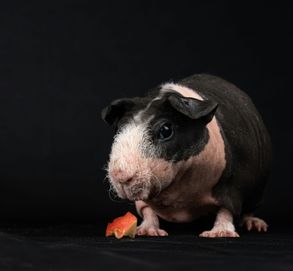
Female guinea pigs reach sexual maturity at 1-2 months of age and are nonseasonally polyestric, meaning they can breed year-round. They go into heat every 15-17 days which lasts for about 6-11 hours and ovulation is spontaneous. Immediately prior to being in heat, female guinea pigs may be more active and may chase cage mates. They also may sway their hindquarters and make a distinct guttural sound.
Guinea pig gestation averages 68 days (range 59-72 days) and litter size ranges from 1-13, but most litters consist of 2-4 pups. The pubic symphysis of the pelvis separates with impending parturition and even more at the time of parturition. However, this separation may be inadequate due to the fusion of pelvic symphysis in sows that are bred for the first time after 7 or 8 months of age, and complications such as dystocia may result. Normal birth is rapid with only a few minutes between births. Continuous straining for 20 minutes or unproductive contractions for more than 2 hours is abnormal and veterinary care should be sought immediately.
Pups ideally should receive sow’s milk for a minimum of 5 days, and the normal lactation period is 3 weeks. Pups often do not survive if they fail to receive sow’s milk for the first 3 to 4 days of life. Weaning occurs at around 21 days or at 180 g body weight.
If your guinea pig is pregnant or you are planning on breeding her it is important to keep her at a healthy weight and avoid obesity. She needs to be on a complete diet, we recommend Oxbow brand pellets and timothy hay. Food and water should always be available. Just with all guinea pigs, Vitamin C supplementation is essential for good health. Plenty of low-stress exercise is important for expectant moms, so make sure she has adequate space to exercise and minimize stress in her environment. Do not make big changes to her cage or diet late in the pregnancy.
Good pre-natal is important for pregnant guinea pigs too. Your veterinarian will recommend ultrasounds to check the health of the growing pups as well as radiographs later in the pregnancy to determine the number of babies she is expecting.
Unfortunately, pregnancy and delivery can be dangerous for guinea pigs just like in human women. If you have a litter that is orphaned the best option is to find another new mother who is willing to foster the pups. If there is no suitable foster mother, the young can be fed from a dropper or pet nurser beginning at 12 to 24 hours after birth. Feeding the pups every 2 hours until 5 days of age, after which feeding every 4 hours becomes sufficient. The hand-rearing formula should approximate guinea pig milk, which contains 4% fat, 8% protein, and 3% lactose. Evaporated milk mixed with an equal amount of water can be used. Guinea pigs begin nibbling on solid food at 2 days of age, and guinea pig pellets moistened with water or formula can be offered at that time.
For those not wishing their guinea pigs to breed we recommend either keeping males and females separate after 1 month of age or get them spayed and neutered.
Copyright © All Rights Reserved
